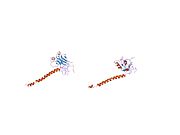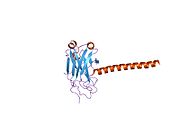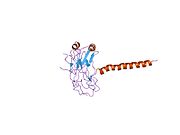TRAF3
| TRAF3 | |||||||||||||||||||||||||||||||||||||||||||||||||||
|---|---|---|---|---|---|---|---|---|---|---|---|---|---|---|---|---|---|---|---|---|---|---|---|---|---|---|---|---|---|---|---|---|---|---|---|---|---|---|---|---|---|---|---|---|---|---|---|---|---|---|---|
 | |||||||||||||||||||||||||||||||||||||||||||||||||||
| |||||||||||||||||||||||||||||||||||||||||||||||||||
| Identifiers | |||||||||||||||||||||||||||||||||||||||||||||||||||
| Aliases | TRAF3, CAP-1, CAP1, CD40bp, CRAF1, IIAE5, LAP1, TNF receptor associated factor 3, RNF118 | ||||||||||||||||||||||||||||||||||||||||||||||||||
| External IDs | OMIM: 601896; MGI: 108041; HomoloGene: 7981; GeneCards: TRAF3; OMA:TRAF3 - orthologs | ||||||||||||||||||||||||||||||||||||||||||||||||||
| |||||||||||||||||||||||||||||||||||||||||||||||||||
| |||||||||||||||||||||||||||||||||||||||||||||||||||
| |||||||||||||||||||||||||||||||||||||||||||||||||||
| |||||||||||||||||||||||||||||||||||||||||||||||||||
| |||||||||||||||||||||||||||||||||||||||||||||||||||
| Wikidata | |||||||||||||||||||||||||||||||||||||||||||||||||||
| |||||||||||||||||||||||||||||||||||||||||||||||||||
TNF receptor-associated factor (TRAF3) is a protein that in humans is encoded by the TRAF3 gene. [5][6][7]
Function
The protein encoded by this gene is a member of the TNF receptor associated factor (TRAF) protein family. TRAF proteins associate with, and mediate the signal transduction from, members of the TNF receptor (TNFR) superfamily. This protein participates in the signal transduction of CD40, a TNFR family member important for the activation of the immune response. This protein is found to be a critical component of the lymphotoxin-beta receptor (LTbetaR) signaling complex, which induces NF-kappaB activation and cell death initiated by LTbeta ligation. Epstein-Barr virus-encoded latent infection membrane protein-1 (LMP1) can interact with this and several other members of the TRAF family, which may be essential for the oncogenic effects of LMP1. Three alternatively spliced transcript variants encoding two distinct isoforms have been reported.[8]
Interactions
TRAF3 has been shown to interact with:
Clinical significance
TRAF3 Haploinsufficiency Syndrome
Haploinsufficiency of TRAF3 in humans is associated with various immunodeficiency and autoimmunity diseases.[26][27]
References
- ^ a b c GRCh38: Ensembl release 89: ENSG00000131323 – Ensembl, May 2017
- ^ a b c GRCm38: Ensembl release 89: ENSMUSG00000021277 – Ensembl, May 2017
- ^ "Human PubMed Reference:". National Center for Biotechnology Information, U.S. National Library of Medicine.
- ^ "Mouse PubMed Reference:". National Center for Biotechnology Information, U.S. National Library of Medicine.
- ^ Cheng G, Cleary AM, Ye ZS, Hong DI, Lederman S, Baltimore D (March 1995). "Involvement of CRAF1, a relative of TRAF, in CD40 signaling". Science. 267 (5203): 1494–8. Bibcode:1995Sci...267.1494C. doi:10.1126/science.7533327. PMID 7533327. S2CID 39062705.
- ^ Sato T, Irie S, Reed JC (January 1995). "A novel member of the TRAF family of putative signal transducing proteins binds to the cytosolic domain of CD40". FEBS Letters. 358 (2): 113–8. doi:10.1016/0014-5793(94)01406-Q. PMID 7530216. S2CID 36111713.
- ^ Mosialos G, Birkenbach M, Yalamanchili R, VanArsdale T, Ware C, Kieff E (February 1995). "The Epstein-Barr virus transforming protein LMP1 engages signaling proteins for the tumor necrosis factor receptor family". Cell. 80 (3): 389–99. doi:10.1016/0092-8674(95)90489-1. PMID 7859281.
- ^ "Entrez Gene: TRAF3 TNF receptor-associated factor 3".
- ^ Yamamoto H, Kishimoto T, Minamoto S (November 1998). "NF-kappaB activation in CD27 signaling: involvement of TNF receptor-associated factors in its signaling and identification of functional region of CD27". Journal of Immunology. 161 (9): 4753–9. doi:10.4049/jimmunol.161.9.4753. PMID 9794406. S2CID 22442601.
- ^ Akiba H, Nakano H, Nishinaka S, Shindo M, Kobata T, Atsuta M, Morimoto C, Ware CF, Malinin NL, Wallach D, Yagita H, Okumura K (May 1998). "CD27, a member of the tumor necrosis factor receptor superfamily, activates NF-kappaB and stress-activated protein kinase/c-Jun N-terminal kinase via TRAF2, TRAF5, and NF-kappaB-inducing kinase". The Journal of Biological Chemistry. 273 (21): 13353–8. doi:10.1074/jbc.273.21.13353. PMID 9582383.
- ^ Tsukamoto N, Kobayashi N, Azuma S, Yamamoto T, Inoue J (February 1999). "Two differently regulated nuclear factor kappaB activation pathways triggered by the cytoplasmic tail of CD40". Proceedings of the National Academy of Sciences of the United States of America. 96 (4): 1234–9. Bibcode:1999PNAS...96.1234T. doi:10.1073/pnas.96.4.1234. PMC 15446. PMID 9990007.
- ^ Hu HM, O'Rourke K, Boguski MS, Dixit VM (December 1994). "A novel RING finger protein interacts with the cytoplasmic domain of CD40". The Journal of Biological Chemistry. 269 (48): 30069–72. doi:10.1016/S0021-9258(18)43772-6. PMID 7527023.
- ^ Ni CZ, Welsh K, Leo E, Chiou CK, Wu H, Reed JC, Ely KR (September 2000). "Molecular basis for CD40 signaling mediated by TRAF3". Proceedings of the National Academy of Sciences of the United States of America. 97 (19): 10395–9. Bibcode:2000PNAS...9710395N. doi:10.1073/pnas.97.19.10395. PMC 27035. PMID 10984535.
- ^ Roy N, Deveraux QL, Takahashi R, Salvesen GS, Reed JC (December 1997). "The c-IAP-1 and c-IAP-2 proteins are direct inhibitors of specific caspases". The EMBO Journal. 16 (23): 6914–25. doi:10.1093/emboj/16.23.6914. PMC 1170295. PMID 9384571.
- ^ Lee ZH, Lee SE, Kwack K, Yeo W, Lee TH, Bae SS, Suh PG, Kim HH (March 2001). "Caspase-mediated cleavage of TRAF3 in FasL-stimulated Jurkat-T cells". Journal of Leukocyte Biology. 69 (3): 490–6. doi:10.1189/jlb.69.3.490. PMID 11261798. S2CID 34256107.
- ^ Leo E, Deveraux QL, Buchholtz C, Welsh K, Matsuzawa S, Stennicke HR, Salvesen GS, Reed JC (March 2001). "TRAF1 is a substrate of caspases activated during tumor necrosis factor receptor-alpha-induced apoptosis". The Journal of Biological Chemistry. 276 (11): 8087–93. doi:10.1074/jbc.M009450200. PMID 11098060.
- ^ VanArsdale TL, VanArsdale SL, Force WR, Walter BN, Mosialos G, Kieff E, Reed JC, Ware CF (March 1997). "Lymphotoxin-beta receptor signaling complex: role of tumor necrosis factor receptor-associated factor 3 recruitment in cell death and activation of nuclear factor kappaB". Proceedings of the National Academy of Sciences of the United States of America. 94 (6): 2460–5. Bibcode:1997PNAS...94.2460V. doi:10.1073/pnas.94.6.2460. PMC 20110. PMID 9122217.
- ^ Wu MY, Wang PY, Han SH, Hsieh SL (April 1999). "The cytoplasmic domain of the lymphotoxin-beta receptor mediates cell death in HeLa cells". The Journal of Biological Chemistry. 274 (17): 11868–73. doi:10.1074/jbc.274.17.11868. PMID 10207006.
- ^ Marsters SA, Ayres TM, Skubatch M, Gray CL, Rothe M, Ashkenazi A (May 1997). "Herpesvirus entry mediator, a member of the tumor necrosis factor receptor (TNFR) family, interacts with members of the TNFR-associated factor family and activates the transcription factors NF-kappaB and AP-1". The Journal of Biological Chemistry. 272 (22): 14029–32. doi:10.1074/jbc.272.22.14029. PMID 9162022.
- ^ Gamper C, van Eyndhoven WG, Schweiger E, Mossbacher M, Koo B, Lederman S (2000). "TRAF-3 interacts with p62 nucleoporin, a component of the nuclear pore central plug that binds classical NLS-containing import complexes". Molecular Immunology. 37 (1–2): 73–84. doi:10.1016/s0161-5890(00)00015-8. PMID 10781837.
- ^ Galibert L, Tometsko ME, Anderson DM, Cosman D, Dougall WC (December 1998). "The involvement of multiple tumor necrosis factor receptor (TNFR)-associated factors in the signaling mechanisms of receptor activator of NF-kappaB, a member of the TNFR superfamily". The Journal of Biological Chemistry. 273 (51): 34120–7. doi:10.1074/jbc.273.51.34120. PMID 9852070.
- ^ Kim HH, Lee DE, Shin JN, Lee YS, Jeon YM, Chung CH, Ni J, Kwon BS, Lee ZH (January 1999). "Receptor activator of NF-kappaB recruits multiple TRAF family adaptors and activates c-Jun N-terminal kinase". FEBS Letters. 443 (3): 297–302. doi:10.1016/s0014-5793(98)01731-1. PMID 10025951. S2CID 46210019.
- ^ Bouwmeester T, Bauch A, Ruffner H, Angrand PO, Bergamini G, Croughton K, Cruciat C, Eberhard D, Gagneur J, Ghidelli S, Hopf C, Huhse B, Mangano R, Michon AM, Schirle M, Schlegl J, Schwab M, Stein MA, Bauer A, Casari G, Drewes G, Gavin AC, Jackson DB, Joberty G, Neubauer G, Rick J, Kuster B, Superti-Furga G (February 2004). "A physical and functional map of the human TNF-alpha/NF-kappa B signal transduction pathway". Nature Cell Biology. 6 (2): 97–105. doi:10.1038/ncb1086. PMID 14743216. S2CID 11683986.
- ^ Rothe M, Xiong J, Shu HB, Williamson K, Goddard A, Goeddel DV (August 1996). "I-TRAF is a novel TRAF-interacting protein that regulates TRAF-mediated signal transduction". Proceedings of the National Academy of Sciences of the United States of America. 93 (16): 8241–6. Bibcode:1996PNAS...93.8241R. doi:10.1073/pnas.93.16.8241. PMC 38654. PMID 8710854.
- ^ Kuai J, Nickbarg E, Wooters J, Qiu Y, Wang J, Lin LL (April 2003). "Endogenous association of TRAF2, TRAF3, cIAP1, and Smac with lymphotoxin beta receptor reveals a novel mechanism of apoptosis". The Journal of Biological Chemistry. 278 (16): 14363–9. doi:10.1074/jbc.M208672200. PMID 12571250.
- ^ Lin M, Ji X, Lv Y, Cui D, Xie J (2023). "The Roles of TRAF3 in Immune Responses". Disease Markers. 2023: 7787803. doi:10.1155/2023/7787803. PMC 9949957. PMID 36845015.
- ^ Hornick EL, Bishop GA (2023). "TRAF3: Guardian of T lymphocyte functions". Frontiers in Immunology. 14: 1129251. doi:10.3389/fimmu.2023.1129251. PMC 9940752. PMID 36814922.
Further reading
- Wajant H, Henkler F, Scheurich P (June 2001). "The TNF-receptor-associated factor family: scaffold molecules for cytokine receptors, kinases and their regulators". Cellular Signalling. 13 (6): 389–400. doi:10.1016/S0898-6568(01)00160-7. PMID 11384837.
- Bradley JR, Pober JS (October 2001). "Tumor necrosis factor receptor-associated factors (TRAFs)". Oncogene. 20 (44): 6482–91. doi:10.1038/sj.onc.1204788. PMID 11607847.
- Saha SK, Cheng G (April 2006). "TRAF3: a new regulator of type I interferons". Cell Cycle. 5 (8): 804–7. doi:10.4161/cc.5.8.2637. PMID 16582590.
- Hu HM, O'Rourke K, Boguski MS, Dixit VM (December 1994). "A novel RING finger protein interacts with the cytoplasmic domain of CD40". The Journal of Biological Chemistry. 269 (48): 30069–72. doi:10.1016/S0021-9258(18)43772-6. PMID 7527023.
- Cheng G, Cleary AM, Ye ZS, Hong DI, Lederman S, Baltimore D (March 1995). "Involvement of CRAF1, a relative of TRAF, in CD40 signaling". Science. 267 (5203): 1494–8. Bibcode:1995Sci...267.1494C. doi:10.1126/science.7533327. PMID 7533327. S2CID 39062705.
- Hsu H, Shu HB, Pan MG, Goeddel DV (January 1996). "TRADD-TRAF2 and TRADD-FADD interactions define two distinct TNF receptor 1 signal transduction pathways". Cell. 84 (2): 299–308. doi:10.1016/S0092-8674(00)80984-8. PMID 8565075.
- Hsu H, Huang J, Shu HB, Baichwal V, Goeddel DV (April 1996). "TNF-dependent recruitment of the protein kinase RIP to the TNF receptor-1 signaling complex". Immunity. 4 (4): 387–96. doi:10.1016/S1074-7613(00)80252-6. PMID 8612133.
- Butch ER, Guan KL (February 1996). "Characterization of ERK1 activation site mutants and the effect on recognition by MEK1 and MEK2". The Journal of Biological Chemistry. 271 (8): 4230–5. doi:10.1074/jbc.271.8.4230. PMID 8626767.
- Gedrich RW, Gilfillan MC, Duckett CS, Van Dongen JL, Thompson CB (May 1996). "CD30 contains two binding sites with different specificities for members of the tumor necrosis factor receptor-associated factor family of signal transducing proteins". The Journal of Biological Chemistry. 271 (22): 12852–8. doi:10.1074/jbc.271.22.12852. PMID 8662842.
- Nakano H, Oshima H, Chung W, Williams-Abbott L, Ware CF, Yagita H, Okumura K (June 1996). "TRAF5, an activator of NF-kappaB and putative signal transducer for the lymphotoxin-beta receptor". The Journal of Biological Chemistry. 271 (25): 14661–4. doi:10.1074/jbc.271.25.14661. PMID 8663299.
- Rothe M, Xiong J, Shu HB, Williamson K, Goddard A, Goeddel DV (August 1996). "I-TRAF is a novel TRAF-interacting protein that regulates TRAF-mediated signal transduction". Proceedings of the National Academy of Sciences of the United States of America. 93 (16): 8241–6. Bibcode:1996PNAS...93.8241R. doi:10.1073/pnas.93.16.8241. PMC 38654. PMID 8710854.
- Hubberstey A, Yu G, Loewith R, Lakusta C, Young D (June 1996). "Mammalian CAP interacts with CAP, CAP2, and actin". Journal of Cellular Biochemistry. 61 (3): 459–66. doi:10.1002/(SICI)1097-4644(19960601)61:3<459::AID-JCB13>3.0.CO;2-E. PMID 8761950. S2CID 46076387.
- VanArsdale TL, VanArsdale SL, Force WR, Walter BN, Mosialos G, Kieff E, Reed JC, Ware CF (March 1997). "Lymphotoxin-beta receptor signaling complex: role of tumor necrosis factor receptor-associated factor 3 recruitment in cell death and activation of nuclear factor kappaB". Proceedings of the National Academy of Sciences of the United States of America. 94 (6): 2460–5. Bibcode:1997PNAS...94.2460V. doi:10.1073/pnas.94.6.2460. PMC 20110. PMID 9122217.
- Marsters SA, Ayres TM, Skubatch M, Gray CL, Rothe M, Ashkenazi A (May 1997). "Herpesvirus entry mediator, a member of the tumor necrosis factor receptor (TNFR) family, interacts with members of the TNFR-associated factor family and activates the transcription factors NF-kappaB and AP-1". The Journal of Biological Chemistry. 272 (22): 14029–32. doi:10.1074/jbc.272.22.14029. PMID 9162022.
- Boucher LM, Marengère LE, Lu Y, Thukral S, Mak TW (April 1997). "Binding sites of cytoplasmic effectors TRAF1, 2, and 3 on CD30 and other members of the TNF receptor superfamily". Biochemical and Biophysical Research Communications. 233 (3): 592–600. doi:10.1006/bbrc.1997.6509. PMID 9168896.
- Song HY, Régnier CH, Kirschning CJ, Goeddel DV, Rothe M (September 1997). "Tumor necrosis factor (TNF)-mediated kinase cascades: bifurcation of nuclear factor-kappaB and c-jun N-terminal kinase (JNK/SAPK) pathways at TNF receptor-associated factor 2". Proceedings of the National Academy of Sciences of the United States of America. 94 (18): 9792–6. Bibcode:1997PNAS...94.9792S. doi:10.1073/pnas.94.18.9792. PMC 23270. PMID 9275204.
- Force WR, Cheung TC, Ware CF (December 1997). "Dominant negative mutants of TRAF3 reveal an important role for the coiled coil domains in cell death signaling by the lymphotoxin-beta receptor". The Journal of Biological Chemistry. 272 (49): 30835–40. doi:10.1074/jbc.272.49.30835. PMID 9388227.
- v
- t
- e
-
 1flk: MOLECULAR BASIS FOR CD40 SIGNALING MEDIATED BY TRAF3
1flk: MOLECULAR BASIS FOR CD40 SIGNALING MEDIATED BY TRAF3 -
 1fll: MOLECULAR BASIS FOR CD40 SIGNALING MEDIATED BY TRAF3
1fll: MOLECULAR BASIS FOR CD40 SIGNALING MEDIATED BY TRAF3 -
 1kzz: DOWNSTREAM REGULATOR TANK BINDS TO THE CD40 RECOGNITION SITE ON TRAF3
1kzz: DOWNSTREAM REGULATOR TANK BINDS TO THE CD40 RECOGNITION SITE ON TRAF3 -
 1l0a: DOWNSTREAM REGULATOR TANK BINDS TO THE CD40 RECOGNITION SITE ON TRAF3
1l0a: DOWNSTREAM REGULATOR TANK BINDS TO THE CD40 RECOGNITION SITE ON TRAF3 -
 1rf3: Structurally Distinct Recognition Motifs in Lymphotoxin-B Receptor and CD40 for TRAF-mediated Signaling
1rf3: Structurally Distinct Recognition Motifs in Lymphotoxin-B Receptor and CD40 for TRAF-mediated Signaling -
 1zms: LMP1 Protein binds to TRAF3 as a structural CD40
1zms: LMP1 Protein binds to TRAF3 as a structural CD40 -
 2gkw: Key contacts promote recognition of BAFF-R by TRAF3
2gkw: Key contacts promote recognition of BAFF-R by TRAF3

























